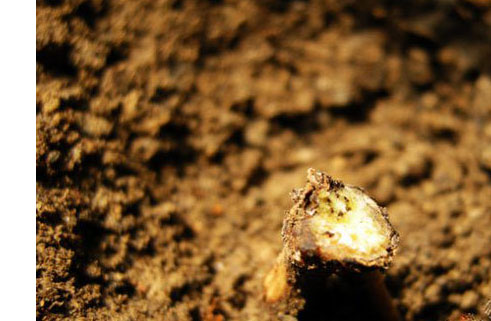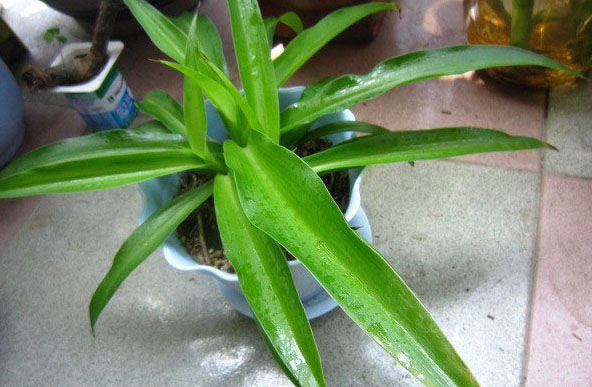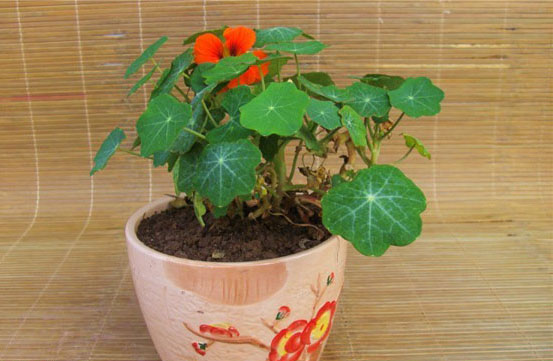Treatment of Fusarium wilt of Clematis clematis
Clematis seldom has diseases and insect pests, and the most common disease is clematis wilt. The probability of clematis wilt in foreign books is 5-10%, and rainy Fusarium wilt will be more serious in spring. Clematis wilt is mostly caused by moist air and molds invade branches.
Often, after a spring rain, as soon as I ushered in the joyful sunshine, I found a few small iron twigs with drooping heads, with a lot of buds, super distressing. If you look down the branch, you will find a blackened place on the branch somewhere. Cut it off, and the blackened part of the branch is already dry and hollow in the middle. Without the nutrition supplied by the root system, the branch will lose its vitality. The blackening point will start from the semi-textured part of the branch-anywhere between the roots.
Although Fusarium wilt occurs frequently, it is not fatal to Xiaoti. If only two branches wither, the treatment is to prune the withered branches from the blackspot. It will have no effect on other healthy branches. If the whole plant is withered, only the roots are retained after all pruning, and new branches may grow again in autumn.

Here are some suggestions for the treatment of clematis wilt:
L, found that diseased branches should be dealt with immediately, usually-the root branches have symptoms, as long as the treatment is timely, the healthy branches will not be affected.
2. Contrast-below, all the leaves of the diseased branches droop from top to bottom. If only part of the leaves of the root branches droop, you need to find other reasons first, such as the tight bundle affects the circulation, where the branches have been broken, and so on. Treatment of Fusarium wilt of Clematis clematis
Clematis seldom has diseases and insect pests, and the most common disease is clematis wilt. The probability of clematis wilt in foreign books is 5-10%, and rainy Fusarium wilt will be more serious in spring. Clematis wilt is mostly caused by moist air and molds invade branches.
Often, after a spring rain, just ushered in the delightful sunshine, they found a few small iron twigs with drooping heads, but also with a lot of buds, super distressed. If you look down the branches, you will find a blackened place on the branches somewhere. Cut off, the blackened parts of the branches are already dry and hollow in the middle. Without the nutrition supplied by the root system, the branch will lose its vitality. The blackening point will start from the semi-lignified part of the branch to anywhere between the roots.
Although Fusarium wilt occurs frequently, it is generally not fatal to small iron. If only one or two branches wither, the treatment is to prune the withered branches from the blackspots. It will have no effect on other healthy branches. If the whole plant is withered, only the roots are retained after all pruning, and new branches may grow again in autumn.
Here are some suggestions for the treatment of clematis wilt:
1. When diseased branches are found, they should be dealt with immediately. It is usually a branch with symptoms. As long as the treatment is timely, healthy branches will not be affected.
2. In contrast, all the leaves of the diseased branches droop from top to bottom. If only part of the leaves of a branch droop, other reasons need to be found first, such as the tight bundle affects the circulation, where the branches have been broken, and so on.
3. Not 100% of Fusarium wilt can be recovered, but the more timely and cleaner the treatment, the stronger the plant (older seedlings, developed roots, more branches), the greater the likelihood of recovery. Generally speaking, most of the seedlings that have been treated for more than three years will issue new shoots in time.
4. When we deal with it, it will be completely cut clean, even if it is sometimes cut to the root, the small iron will still grow new buds.
5. Fusarium wilt should be found and dealt with in time, and the infected stems must be cut clean, otherwise it is difficult to grow new branches. Sometimes when a branch is infected in the place of the branch, it is difficult to retain the remaining healthy branches, such as the above illustration, we simply cut them all. You can also try to leave healthy branches for more observation, once the healthy branches are cut off in time.
6. Clematis wilt has been infected for some time when it shows symptoms, but it is not easy to detect. Therefore, as soon as the disease is found, it should be dealt with immediately, the sooner the easier to recover, do not procrastinate. At this time of observation, if the disease is getting worse, it may be infected from one branch to two or three branches or the whole plant.
7. When Xiao tie has Fusarium wilt, the whole branch will droop from top to bottom, which is easy to identify. If only the leaves at the root are yellow and dry, it is normal.
8. The fleshy root of Clematis is nutritious, which can provide the nutrition needed for germination after cutting.
9. Clematis wilt is like catching a cold. There are too many uncertainties, and it is difficult to prevent. At present, we are mixing plant ash or organic lime in the soil. Or sprinkle a little plant ash on the soil surface where the roots are combined before each rainy season. Seems to work a little bit. Fusarium wilt is most common when there is a sudden sunny day after the rainy season. However, as Xiao tie adapts more and more in your home, the incidence of the disease will decrease year by year. The disease is generally fine as long as it is found in time and does not infect the roots.
10. in case it is withered when cut to the soil, the topsoil needs to be removed until the focus is cut clean.
Treatment of clematis wilt (figure) Clematis seldom has diseases and insect pests, and the most common disease is clematis wilt. The probability of clematis wilt in foreign books is 5-10%, and rainy Fusarium wilt will be more serious in spring. Clematis wilt is mostly caused by moist air and molds invading branches. Often, after a spring rain, just ushered in the delightful sunshine, they found a few small iron twigs with drooping heads, but also with a lot of buds, super distressed. If you look down the branches, you will find a blackened place on the branches somewhere. Cut off, the blackened parts of the branches are already dry and hollow in the middle. Without the nutrition supplied by the root system, the branch will lose its vitality. The blackening point will start from the semi-lignified part of the branch to anywhere between the roots. Although Fusarium wilt occurs frequently, it is generally not fatal to small iron. If only one or two branches wither, the treatment is to prune the withered branches from the blackspots. It will have no effect on other healthy branches. If the whole plant is withered, only the roots are retained after all pruning, and new branches may grow again in autumn. The following are the suggestions for the treatment of clematis wilt: 1. It is found that the diseased branch should be treated immediately, usually a branch has symptoms, as long as the treatment is timely, it will not affect the healthy branch. 2. In contrast, all the leaves of the diseased branches droop from top to bottom. If only part of the leaves of a branch droop, other reasons need to be found first, such as the tight bundle affects the circulation, where the branches have been broken, and so on. 3. Not 100% of Fusarium wilt can be recovered, but the more timely and cleaner the treatment, the stronger the plant (older seedlings, developed roots, more branches), the greater the likelihood of recovery. Generally speaking, most of the seedlings that have been treated for more than three years will issue new shoots in time. 4. When we deal with it, it will be completely cut clean, even if it is sometimes cut to the root, the small iron will still grow new buds. 5. Fusarium wilt should be found and dealt with in time, and the infected stems must be cut clean, otherwise it is difficult to grow new branches. Sometimes when a branch is infected in the place of the branch, it is difficult to retain the remaining healthy branches, such as the above illustration, we simply cut them all. You can also try to leave healthy branches for more observation, once the healthy branches are cut off in time. 6. Clematis wilt has been infected for some time when it shows symptoms, but it is not easy to detect. Therefore, as soon as the disease is found, it should be dealt with immediately, the sooner the easier to recover, do not procrastinate. At this time of observation, if the disease is getting worse, it may be infected from one branch to two or three branches or the whole plant. 7. When Xiao tie has Fusarium wilt, the whole branch will droop from top to bottom, which is easy to identify. If only the leaves at the root are yellow and dry, it is normal. 8. The fleshy root of Clematis is nutritious, which can provide the nutrition needed for germination after cutting. 9. Clematis wilt is like catching a cold. There are too many uncertainties, and it is difficult to prevent. At present, we are mixing plant ash or organic lime in the soil. Or sprinkle a little plant ash on the soil surface where the roots are combined before each rainy season. Seems to work a little bit. Fusarium wilt is most common when there is a sudden sunny day after the rainy season. However, as Xiao tie adapts more and more in your home, the incidence of the disease will decrease year by year. The disease is generally fine as long as it is found in time and does not infect the roots. 10. in case it is withered when cut to the soil, the topsoil needs to be removed until the focus is cut clean.
- Prev

What is the reason for the blackening of the leaf tip of Cymbidium
Cymbidium is a very popular foliage plant, many flower friends have found a sense of achievement in growing flowers, but they will also encounter the situation that the leaf tip of the orchid is black, although it will not affect the growth of the orchid, but it will greatly affect the beauty.
- Next

The leaves of Clematis paniculata turn yellow.
Generally speaking, there are many reasons for the yellowing of the leaves of Anoplophora acuminata. Water, fertilizer, light and insect pests may all be the causes, so when reading the article, you should judge the reason for the yellowing of the leaves according to your own actual situation. Next, let's talk about various reasons for the yellowing and watering of the leaves of Golden Lotus.
Related
- Fuxing push coffee new agricultural production and marketing class: lack of small-scale processing plants
- Jujube rice field leisure farm deep ploughing Yilan for five years to create a space for organic food and play
- Nongyu Farm-A trial of organic papaya for brave women with advanced technology
- Four points for attention in the prevention and control of diseases and insect pests of edible fungi
- How to add nutrient solution to Edible Fungi
- Is there any good way to control edible fungus mites?
- Open Inoculation Technology of Edible Fungi
- Is there any clever way to use fertilizer for edible fungus in winter?
- What agents are used to kill the pathogens of edible fungi in the mushroom shed?
- Rapid drying of Edible Fungi

